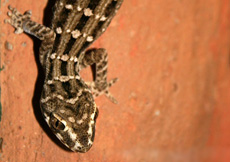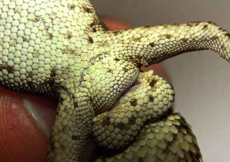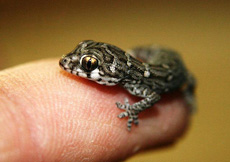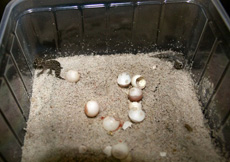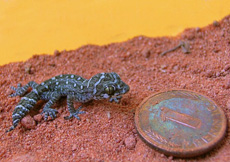Hemidactylus imbricatus (Originally known as Teratolepis fasciata)
(BLYTH, 1853)
Distribution:
The Indus Delta, Pakistan
Description:
Hemidactylus imbricatus reaches an overall length of about 10 centimeters. The tail is thick and easy to tell apart from the body, it resembles a beet in appearance (hence the common German name of beet-tail Viper Gecko). The tail is used as a fat storage reservoir for lean periods, as is the case with many desert dwelling geckos. Due to this you can see the nutritional status of the animal very well. The scales on the tail resemble roof tiles, while on the other hand the scales on the body are small and granular. The pattern of Hemidactylus imbricatus consists of beige and black stripes, which run from neck to tail. Periodically they are interrupted by white dots, which in turn unite to form transverse bands.
The sexes are very easily distinguished from one another on the basis of preanal pores, which are found only on males. Based on this trait it is possible with some experience and the help of a good magnifying glass to determine their sex at around 2-3 months of age. In adult animals however it is very easy to determine the difference based on the pronounced hemipenis pockets.
Habitat:
Information about the natural habitat of Hemidactylus imbricatus is rarely found in literature. Anderson (1964) was able to find this species in the cemeteries of Pakistan between the cities of Mirpur Sakro and Gharo. They were discovered in hiding during the day on dry loose soil surfaces. A nearby brick wall was also inhabited. They shared their habitat in conjunction with Hemidactylus brooki, H. persicus, H. flaviviridis, Cyrtopodion kachhensis and Eublepharis macularius.
Husbandry and Breeding:
Hemidactylus imbricatus is often described as a bottom dweller. However in their time with me I have observed them climbing often, so I have created a false rock background while building their enclosure. Their enclosure measures 30x40x30 centimeters. For the substrate a 2-3 centimeter deep layer of fine sand is recommended. Pieces of bark and small pieces of cork, or tubes serve as hiding places. A shallow water dish should also be a part of the terrarium decor.
I keep the animals throughout the year as a group consisting of one male and two females. These geckos are crepuscular and nocturnal, once nighttime begins they leave hiding. After acclimatization, they may come out during the daytime, but they are not very active. Although food is also accepted at daytime, I feed them mostly at a later hour, to come as close as possible to their natural conditions. The adults are fed once to twice weekly with a variety of insects, they can overpower relatively large prey. The food for my animals mainly consists of medium-sized crickets, but sometimes I may offer them smaller food consisting of cockroaches, wax moth larvae, crickets and firebrats. These geckos are very greedy and you can even feed them via tweezers. However I prefer to let them hunt independently, that way I am certain all geckos have sufficient food.
Every two days the terrarium should be sprayed lightly. In the summer the geckos are kept between 25-30°C (77-86 °F) daily, followed by a nighttime drop of about 3-5 degrees. The illumination period during the summer should be 12 hours daily and 8-10 hours during the winter. In winter the temperatures of the terrarium should remain around 5-10 degrees cooler, allowing the animals to rest before the mating season returns. After mating takes place bite marks may be visible on the neck of the female. After a 30 day gestation period the female will bury her eggs in loose sand. The females often prefer a specific place for laying eggs, so they should not be too hard to find after the first time around. I usually gather all of the eggs and place them on a bit of sand, the edges of sand are then slightly moistened before being placed into an incubator. During the day I keep the temperature in the incubator at 26.5°C (80°F) and at night they are kept around 24.5°C (76°F), which has led to a nearly balanced sex ratio. After about 60 days the eggs hatch and the young are similar in appearance to their parents. Within 24 hours the newly hatched animals shed for the first time, for this reason I usually leave them in the incubator still, as it helps aid in their shed. After 24 hours I transfer them to a small converted household container that is decorated with a thin layer of sand and a piece of cork. Young animals are fed every 2-3 days with micro food consisting of crickets, springtails, firebrats and small wax moth larvae. Every other day I mist their enclosure to ensure the geckos can regulate their water intake properly. Under these conditions the young grow very quickly and are sexually mature by 10 months of age, however they should not be used as breeder animals until they are one year or older.
The beet-tail Viper Gecko is a very attractive terrarium inhabitant which is easy to keep, due to their hardiness and low space demands. The provision of small food for the young may occasionally be the only cause for problems. Nevertheless Hemidactylus imbricatus can certainly be recommended to both the experienced or beginning hobbyist.
Literature:
- Anderson, J.A. 1964. A Report on the Gecko Teratolepis fasciata (BLYTH, 1853) J. Bombay Nat. Hist. Soc. 61 (1): 161-171.
